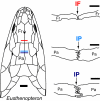Terrestrial-style feeding in a very early aquatic tetrapod is supported by evidence from experimental analysis of suture morphology
- PMID: 17438285
- PMCID: PMC1855429
- DOI: 10.1073/pnas.0701706104
Terrestrial-style feeding in a very early aquatic tetrapod is supported by evidence from experimental analysis of suture morphology
Abstract
There is no consensus on when in the fish-tetrapod transition suction feeding, the primary method of prey capture in the aquatic realm, evolved into the direct biting on prey typical of terrestrial animals. Here, we show that differences in the morphology of selected cranial sutures between species that span the fish-tetrapod transition (the Devonian osteolepiform fish Eusthenopteron, the aquatic Devonian tetrapod Acanthostega, and the Permian terrestrial tetrapod Phonerpeton) can be used to infer when terrestrial feeding first appeared. Our approach consists of defining a sutural morphospace, assigning functional fields to that morphospace based on our previous measurements of suture function made during feeding in the living fish Polypterus, inferring the functions of the fossil sutures based on where they fall in the morphospace, and then using the correlation between feeding mode and the patterns of inferred suture function across the skull roof in taxa where feeding mode is unambiguous to infer the feeding mode practiced by Acanthostega. Using this procedure, we find that the suture morphologies of Acanthostega are inconsistent with the hypothesis that it captured prey primarily by means of suction, which suggests that it may have bitten directly on prey at or near the water's edge. Thus, our data strongly support the hypothesis that the terrestrial mode of feeding first emerged in aquatic taxa.
Conflict of interest statement
The authors declare no conflict of interest.
Figures





References
-
- Clack JA, Coates MI. B Mus Natl Hist Nat Paris. 1995;17:359–372.
-
- Ahlberg PE, Luksevics E, Lebedev O. Philos Trans R Soc London B. 1994;343:303–328.
-
- Jarvik E. Basic Structure and Evolution of the Vertebrates. London: Academic; 1980.
-
- Vorobyeva EI, Schultze H-P. In: Origins of the Higher Groups of Tetrapods: Controversy and Consensus. Schultze H-P, Treub L, editors. Ithaca, NY: Cornell Univ Press; 1991. pp. 68–109.
-
- Daeschler EB, Shubin NH, Jenkins FA., Jr Nature. 2006;440:757–763. - PubMed
MeSH terms
LinkOut - more resources
Full Text Sources

